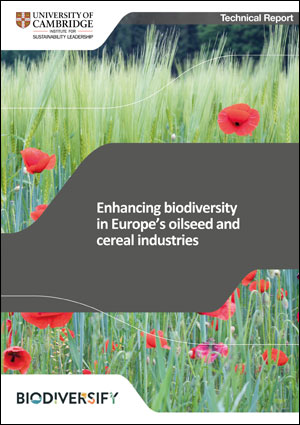Enhancing Agricultural Biodiversity For Ecological Balance

Enhancing Biodiversity in Europe’s Oilseed and Cereal Industries
Our planet is a remarkable place, full of diverse and beautiful landscapes, ecosystems, and species. However, human activities have put immense pressure on the Earth's biodiversity, leading to the extinction of numerous plant and animal species. The oilseed and cereal industries in Europe, in particular, have faced criticism for their impact on biodiversity. In this post, we will explore ways to enhance biodiversity in these industries and promote a sustainable future.
1. Enhancing Biodiversity through Sustainable Farming Practices
One of the most effective ways to promote biodiversity in the oilseed and cereal industries is through sustainable farming practices. This includes reducing the use of chemical pesticides and fertilizers, implementing crop rotation, and promoting the use of organic farming methods. By doing so, we can create a more biodiverse and resilient agricultural landscape.
2. Protecting Natural Habitats and Ecosystems
Another crucial step in enhancing biodiversity is the protection and conservation of natural habitats and ecosystems. This can be achieved by creating wildlife corridors, establishing protected areas, and rewilding abandoned or marginal agricultural land. These measures provide a safe haven for biodiversity, allowing species to thrive and supporting the overall health of ecosystems.
3. Promoting Agroforestry and Silvopastoral Systems
Agroforestry and silvopastoral systems are innovative approaches that combine agriculture with the cultivation of trees and the rearing of livestock. By incorporating trees into agricultural landscapes, we can provide additional habitat for wildlife, improve soil quality, and enhance carbon sequestration. These systems offer numerous benefits while ensuring food production and enhancing biodiversity.
4. Supporting Local and Sustainable Food Systems
By supporting local and sustainable food systems, we can contribute to the preservation of biodiversity in the oilseed and cereal industries. This includes promoting small-scale farmers, organic and regenerative agriculture, and reducing food waste. Local and sustainable food systems often prioritize biodiversity conservation and can play a vital role in creating a more resilient and diverse agricultural sector.
5. Investing in Research and Innovation
To further enhance biodiversity in the oilseed and cereal industries, it is essential to invest in research and innovation. This includes funding studies on the ecological impacts of agricultural practices, developing sustainable farming technologies, and supporting initiatives that promote biodiversity conservation. By continuously improving our understanding and practices, we can make significant strides towards a more biodiverse and sustainable future.
What is the Importance of Enhancing Biodiversity?
Biodiversity is the foundation of healthy ecosystems, providing numerous benefits such as pollination, nutrient cycling, and pest control. Enhancing biodiversity in the oilseed and cereal industries is crucial for maintaining ecosystem services, ensuring the resilience of food production systems, and safeguarding the future of our planet.
Ideas For Enhancing Biodiversity:
- Implementing agri-environment schemes that incentivize biodiversity conservation
- Restoring degraded landscapes through reforestation and habitat restoration projects
- Encouraging the use of native plant species in agricultural landscapes
- Developing strategies to reduce the environmental impact of agricultural inputs
- Collaborating with stakeholders to promote biodiversity-friendly practices
Recommendations For Enhancing Biodiversity:
1. Develop biodiversity action plans in collaboration with farmers, researchers, and conservation organizations
2. Provide financial incentives and support for farmers transitioning to sustainable and biodiversity-friendly practices
3. Raise awareness among consumers about the importance of biodiversity conservation and encourage them to support sustainable food systems
4. Strengthen and enforce regulations that protect natural habitats and require sustainable farming practices
Listicle of Simple Steps to Enhance Biodiversity:
1. Plant native wildflowers in your garden to attract pollinators
2. Support local farmers markets and buy organic, locally-grown produce
3. Reduce food waste by planning meals and composting organic waste
4. Avoid using chemical pesticides and opt for natural alternatives
5. Install bird feeders and nesting boxes to provide habitat for birds
6. Create a small wildlife pond to attract frogs, newts, and other aquatic species
7. Use rain barrels to collect and reuse rainwater in your garden
8. Join or support local conservation organizations working to protect biodiversity
9. Participate in citizen science projects to monitor and report sightings of different species
10. Spread the word about the importance of biodiversity and inspire others to take action
Question & Answer: How does enhancing biodiversity benefit agricultural production?
Enhancing biodiversity in agricultural landscapes can improve pollination, pest control, and nutrient cycling, leading to increased crop yields and fewer pest infestations. Biodiverse ecosystems are more resilient to environmental changes and provide a natural buffer against pests and diseases. Additionally, diverse plant species can improve soil health and fertility, contributing to sustainable agricultural practices.
Summary of Enhancing Biodiversity in Europe’s Oilseed and Cereal Industries
Enhancing biodiversity in the oilseed and cereal industries is crucial for promoting a sustainable and resilient future. By implementing sustainable farming practices, protecting natural habitats, promoting agroforestry, supporting local and sustainable food systems, and investing in research and innovation, we can create a more biodiverse and sustainable agricultural sector. It is essential to recognize the importance of biodiversity and take decisive action to preserve it for future generations.




Post a Comment for "Enhancing Agricultural Biodiversity For Ecological Balance"